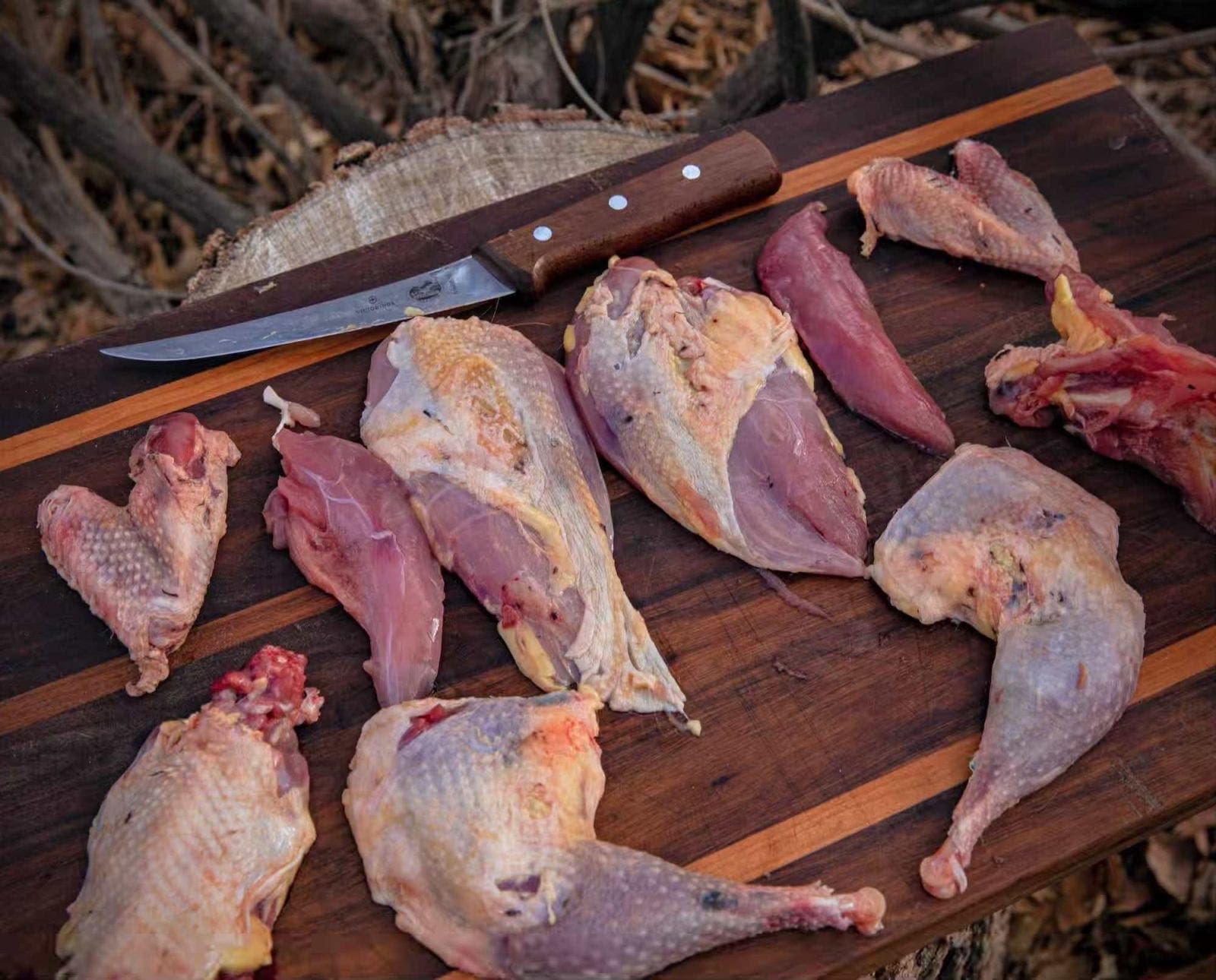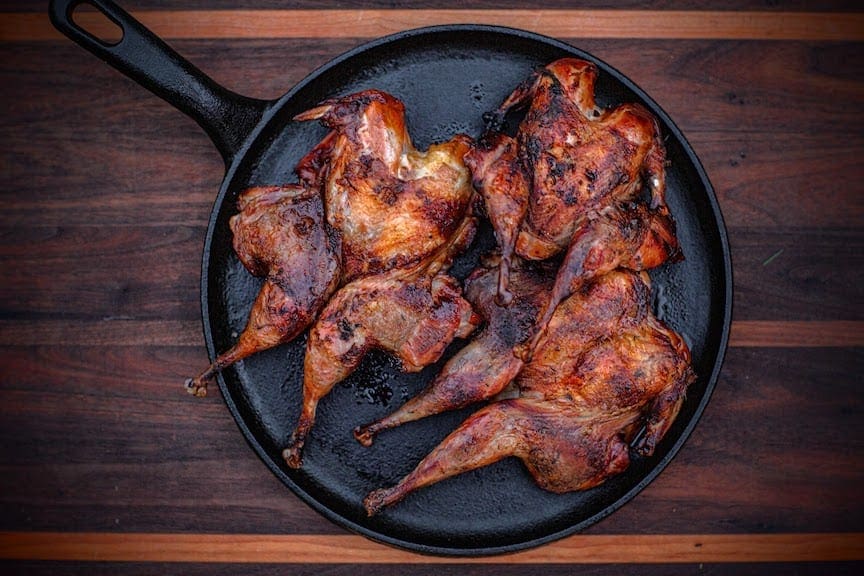Home » Small Game Cooking » How to Butcher an Upland Game Bird
How to Butcher an Upland Game Bird

Jack Hennessy grew up in the South Suburbs of Chicago…
How, when, and why to break down upland game birds for cooking, along with instructions on spatchcocking smaller birds
The first wild turkey I shot, I tried roasting whole in the oven, very Thanksgiving-like. Truth be told, I don’t even think I brined it. It turned out terrible. Because I’m stubborn and/or don’t completely buy into the definition of insanity (doing the same thing over and over but expecting different results), I tried cooking another wild turkey whole again the next year, this time over a charcoal grill. Aside from the breasts, it also was not edible.
What was I doing wrong? I had worked in the kitchen industry for a decade and, professionally speaking, knew how to cook. My mistake? Treating these wild birds as if they were domestic.
Why Break Down Upland Birds?
Wild birds are leaner than their domestic cousins that sit plastic-wrapped at your local grocer. Additionally, as a result of working harder to avoid predators and obtain food, their wing and leg muscles are more developed and therefore tougher. These harder-working cuts (and this is the case with ANY wild game, not just birds) often require low-and-slow cooking methods to yield tender bites.
Smaller birds like quail can indeed be cooked whole. Even a small, younger pheasant can be roasted whole if done properly, but older or larger birds will benefit from being broken down and having the parts cooked separately.
For wild turkeys, I’d argue there is no scenario where you would want to cook that bird whole. For light-meat birds, 160 degrees Fahrenheit is the target internal temp for breasts, while legs will benefit from reaching closer to 180 F. Quail and other birds up to the size of a small pheasant can find that perfect medium as those smaller legs will reach near 180 F while breasts sit around 165 F. On the other hand. the legs, wings, and thighs of a tough, larger bird (like an old rooster or any turkey) will harden at 160 F and, after a couple hours of low cooking (ideally some sort of braise), will finally yield.
It all comes down to mass, so the time it takes heat to penetrate meat for each individual cut will vary quite a bit. For this very reason, I also recommend butterflying or cutting up large tom breasts, since the exterior layers of meat will be overdone by the time the center of the breast hits 160 F, even at low-roasting temps (wild-turkey kebabs made from breasts are incredible, by the way). It is also necessary to apply techniques like tenderizing game birds.
For dark meat birds like sharp-tailed grouse, you won’t want to cook those breasts a degree past medium-rare (135 F), but the ideal leg temp remains the same: somewhere between 170 F and 180 F. For this reason, these birds also benefit from being broken down prior to cooking.
When Should You Break Down Upland Birds?
Determining when to break down your birds versus leaving them whole could also be a matter of how the bird was shot. You don’t want to roast a bird that looks more like hamburger than fowl. The decision could also come down to how you plan to cook the bird. When cooking a wild bird whole, you want a consistent and even flow of heat around the entire bird. This is why roasting racks exist—to allow for heat to move 360 degrees around the bird while cooking. If you lack said consistent and even flow of heat, you may wish to consider breaking the bird down, even for smaller fowl.
For example, a few years ago I joined Lukas Leaf—wild game chef and Sportsmen for the Boundary Waters executive director—and others on a fishing and hunting trip in northern Minnesota in the Boundary Waters. Our team shot a couple of ruffed grouse and Lukas and I planned to pluck and spatchcock them before cooking them in a large cast-iron skillet alongside some lobster mushrooms that Lukas had foraged. We found that when the breasts were cooked and perfectly juicy, the legs were still underdone and chewy. We moved the skillet to indirect heat, added a couple pats of butter, and let them continue to cook for at least another half hour. With no cover and the birds cooking directly on the surface of the skillet, we lacked that consistent, even, 360-degree flow of heat.
Read: The Many Regulations and Laws of Transporting Game Birds
How to Break Down Upland Birds
I won’t get too granular, as the process is fairly simple and gets easier after practice. I start with the legs, spreading each one away from the body and cutting toward the thigh joint. TIP: If you put your index finger parallel to the back of the blade, you have more control and can almost point the knife where you want it to go. This is a technique often used when skinning deer.
Once you find the thigh joint, lightly rock the thigh back and forth until the joint loosens and/or cracks, then just cut away that thigh. Repeat on other side.
Next, I remove the wings by cutting below the armpit and tracing the arm back to the shoulder joint. Similar to the leg, I rock the wing back and forth or turn slightly until that joint starts to pop, then point my knife inside the joint and cut it from the body. Be gentle with both the thighs and the wings; it’s easy to mangle the meat while separating the joints.
The backbone is next for me. So as not to dull your knife, take a pair of kitchen shears and cut down either side of the spine, removing the backbone. Set the backbone aside for stock.
Lastly, I work on the breasts and tenderloins. Yes, birds have tenderloins. They’re that smaller strip of meat behind the breast, closer to ribs. On a mature tom, the tenderloin is the size of a pheasant breast. Tenderloins should ideally be cooked separately because they are far smaller than breasts, with different muscle striations, and will cook faster.
When removing the breasts, I make my first cut as close as possible to the keel bone (the prominent bone protruding from center of chest) on one side, cutting down toward where the tail used to be. I then work the top of my knife along lower portion of breast, moving slowly toward the edge and up to where the wing was as if peeling away the breast from the ribs. While doing this, I am almost writing the letter “V” with my knife. Once I have a full breast peeled back, I cut it from below the wishbone and completely remove it. Repeat on other side. Gently free the tenderloins from breasts—you likely won’t even need a knife to do so. Save the breast bones for stock.
Read: How to Avoid Serving Shot in Your Upland Bird Meals
What About Spatchcocking Game Birds?

Even if you don’t want to break down your upland bird into separate pieces, there’s still value in doing some carving to improve the way the bird cooks.
Spatchcocking is a technique that’s almost as fun to use as it is to say. It’s a technique of cutting out the spine of a bird and flattening the bird so that the legs, wings, and breasts are all on the same plane.
The easiest way to spatchcock a bird is to use a pair of kitchen shears and cut close to the spine. Cut from down both sides, from neck to tail, until you can toss out the spine and open the bird like a book. I usually end up cracking the rib cage as I flatten the bird. This technique can be used on any bird.
Spatchcocking a bird provides two major advantages over roasting one whole. With all the main parts of a bird pressed against a hot skillet or grill, the skin sears evenly. When finished, the skin is crispy and flavorful. Also, a spatchcocked bird—as compared to a trussed, roasted bird—cooks faster, which means the meat stays juicier.
Some spatchcocking tips and ideas:
- For larger birds like pheasant, consider using a grill weight or even a brick covered in aluminum foil placed atop the bird as it sits breast-side-down on the grill or in the skillet, as this will help the meat to sear evenly.
- Spatchcocking ducks is tricky, as breasts can overcook while waiting for the legs to reach 180 F. Consider bringing the duck to room temperature prior to cooking, but place ice packs on the breasts to keep them cold until you begin cooking.
Spatchcocking helps bird legs to cook faster, but they can still be tough after searing. I recommend finishing off in the oven on low heat.
In the past several years, spatchcocking turkeys for Thanksgiving has become more popular, but I would strongly advise against this for wild birds. Actually, I wouldn’t recommend spatchcocking and grilling any wild bird larger than a young pheasant, as even with a low roast in oven afterward, the breasts can overcook while waiting for the legs to begin to yield.
Enjoy! Reach out to me on Instagram (@WildGameJack) with any questions or comments and be sure to check out my other wild game recipes and cooking instructions here.
Jack Hennessy grew up in the South Suburbs of Chicago and didn't start hunting until he attended graduate school in Spokane, Washington, at the age of 26. Hennessy began work in professional kitchens in high school but didn't start writing wild game recipes until he joined the Spokesman-Review in 2014. Since then, his recipes have appeared with Petersen's Hunting, Backcountry Journal, Gun Dog Magazine, among many others. He now lives with his Wirehaired Vizsla, Dudley, in Wichita, Kansas.




I believe the tenderloin is closet to the keel, not the ribs,
I agree that breaking up game birds is the way to go but I’m not convinced that oven baking is necessarily the best way to cook upland game. It took me about 30 years of doing a bad job cooking game before I realized (from Hank Shaw and others) that pay frying or barbequing game, especially ducks and grouse, to rare is the only way to fix these birds. Rare here equates to about 3 to 4 minutes per side. You them add some sort of a sauce, generally involving some form of alcoholic like whiskey or Grand Marnier) over the top. Let the bird rest a few minutes and enjoy.
For the past 2 years I’ve broken down my wild turkeys and cooked the parts three ways. I cook the breast meat sous vide with the the two halves tied together in yin and yang fashion. The meat comes out moist and flavorful and out shines any store-bought turkey breast. The thighs I braise after brining. Prepared ahead of time, they can then be served with the breast meat cooked SV to provide a great contrast. Both meats are great but so different. I save the drumsticks till mid winter which is the right time to make confit.
Good old oven cooking won’t work for any game. Brining helps. Bake in oven bag along with a little wine or stock, sliced onions, herbs, and salt and pepper to taste. Do the stuffing separately and moisten with the baking liquid.
Game birds use their muscles for flight or running. They are tough unless cooked slowly with moist heat.
How does deep frying work? Interesting discussion.